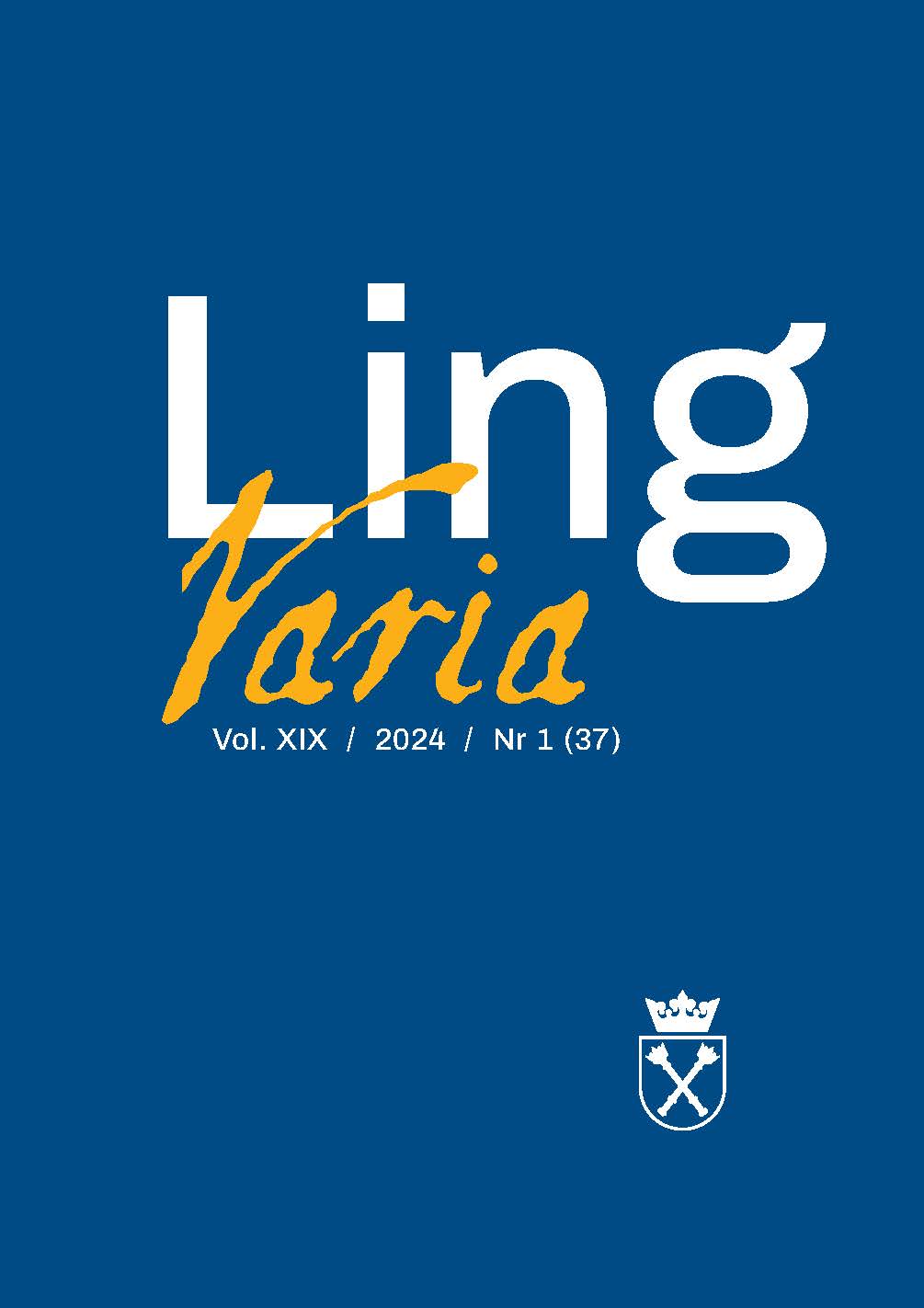Frazeologia gestyczna – znaczenie gestu a znaczenie idiomu
DOI:
https://doi.org/10.12797/LV.19.2024.37.02Słowa kluczowe:
frazeologia gestyczna, gesty, idiom, frazeologizm, komunikacja niewerbalna, semiotyka, dialogAbstrakt
GESTURAL PHRASEOLOGY – THE RELATIONS BETWEEN THE MEANING OF A GESTURE AND THE MEANING OF AN IDIOM
The aim of the article is to discuss the relationship between the meaning of a gesture and the meaning of an idiom which is a literal description of this gesture, i. e. the so-called gestural phraseme (e. g. machnąć na coś ręką [literally: wave your hand at something; metaphorically: give up something], zacierać ręce [rub your hands], rozkładać ręce [throw up one’s hands]). Selected examples of gestures and their phraseological equivalents were discussed, also taking into account their meanings created in direct dialogue. This is particularly important because the meaning of many gestures, which are part of human communicative activity, depends on the context, which, in this case, is the speaker’s entire utterance. Moreover, analyzing gestures and idioms in the dialogue allows us to trace possible ways of co-occurring of these two semiotic modes, which, in turn, sheds some light on the functions of nonverbal behaviour in creating the meaning of utterances. Thus, the research material will contain recordings of TV programs which show politicians’ speeches and utterances of other famous people, thanks to which it is possible to watch spontaneous gesticulation accompanying speech. Conclusions from qualitative research tend to distinguish three types of relationships between a gesture and its idiomatic description: a gesture with a phraseological description accompanies an utterance which it can complement semantically; the gesture precedes the statement, announcing its content; the gesture occurs simultaneously with the idiom that describes it.
Pobrania
Bibliografia
Alibali M.W., Goldin-Meadow S., 1993, Gesture-speech mismatch and mechanisms of learning: What the hands reveal about a child’s state of mind, „Cognitive Psychology” 25 (4), s. 468–523. DOI: 10.1006/cogp.1993.1012. DOI: https://doi.org/10.1006/cogp.1993.1012
Antas J., 2013, Semantyczność ciała. Gesty jako znaki myślenia, Łódź.
Antas J., Kraśnicka-Wilk I., 2013, Funkcje emblematów w strukturze dialogu, „LingVaria” VIII, nr 2 (16), s. 15–42. DOI: 10.12797/LV.08.2013.16.02. DOI: https://doi.org/10.12797/LV.08.2013.16.02
Beattie G., Sale L., 2012, Do metaphoric gestures influence how a message is perceived? The effects of metaphoric gesture-speech matches and mismatches on semantic communication and social judgment, „Semiotica” 192, s. 77–98. DOI: 10.1515/sem-2012-0067. DOI: https://doi.org/10.1515/sem-2012-0067
Ekman P., Friesen W.V., 1969, The repertoire of nonverbal behavior: Categories, origins, usage, and coding, „Semiotica” 1 (1), s. 49–98. DOI: 10.1515/semi.1969.1.1.49. DOI: https://doi.org/10.1515/semi.1969.1.1.49
Grigorʹeva S.A., Grigorʹev N.V., Krejdlin G.E., 2001, Slovarʹ âzyka russkih žestov, Moskva – Vena.
Heliasz-Nowosielska C., 2018, Ruch, gest, gestykulacja w tekstach specjalistycznych i niespecjalistycznych, „LingVaria” XIII, nr 1 (25), s. 255–269. DOI: 10.12797/LV.13.2017.25.19. DOI: https://doi.org/10.12797/LV.13.2017.25.19
Heliasz-Nowosielska C., 2023, (Multi)modalność w narracjach o komunikacji. Relacjonowanie działań komunikacyjnych a ich werbalne i niewerbalne sposoby realizacji, Warszawa. DOI: 10.31338/uw.9788323559788. DOI: https://doi.org/10.31338/uw.9788323559788
Jarmołowicz-Nowikow E., 2019, Intencjonalność komunikacyjna gestów wskazujących, Poznań.
Jarząbek K., 2016, Słownik mowy ciała Polaków, Katowice.
Johnson M., 2015, Znaczenie ciała. Estetyka rozumienia ludzkiego, tłum. J. Płuciennik, Łódź.
Kendon A., 2005, Gestures: Visible Action as Utterance, Cambridge. DOI: 10.1017/CBO9780511807572. DOI: https://doi.org/10.1017/CBO9780511807572
Kępiński A., 1977, Twarz i ręka, „Teksty” nr 2 (32), s. 9–34.
KJP PWN: Korpus języka polskiego PWN, [on-line:] https://sjp.pwn.pl/korpus.
Kozak K., 2007, Polska frazeologia gestu: od informacji somatycznej do idiomu, „Etnolingwistyka. Problemy Języka i Kultury” 19, s. 253–265.
Kraśnicka I., 2020, Meaning in multisemiotic messages: functions of gestures accompanying
speech as elements of utterance structure, „Crossroads. A Journal of English Studies” 31, s. 7–22. DOI: 10.15290/CR.2020.31.4.01. DOI: https://doi.org/10.15290/cr.2020.31.4.01
Kraśnicka-Wilk I., 2018, Między słowem a gestem: frazeologia gestyczna w ujęciu kognitywnym, [w:] M. Gębka-Wolak, I. Kaproń-Charzyńska, J. Kamper-Warejko (red.), Języki słowiańskie w kontekstach kultur dawnych i współczesnych, Toruń, s. 75–87.
Krawczyk A., 1983, Frazeologizmy mimiczne i gestyczne (na materiale gwarowym), „Socjolingwistyka” 5, s. 137–144.
McNeill D., 1985, So You Think Gestures Are Nonverbal?, „Psychological Review” 92 (3), 350–371. DOI: 10.1037/0033-295X.92.3.350. DOI: https://doi.org/10.1037//0033-295X.92.3.350
McNeill D., 1992, Hand and Mind: What Gestures Reveal about Thought, Chicago.
McNeill D., 2005, Gesture and Thought, Chicago. DOI: 10.7208/chicago/9780226514642.001.0001. DOI: https://doi.org/10.7208/chicago/9780226514642.001.0001
McNeill D., 2013, The co-evolution of gesture and speech, and downstream consequences, [w:] C. Müller, A. Cienki, E. Fricke et al. (red.), Body – Language – Communication: An International Handbook on Multimodality in Human Interaction, t. 1 (38.1), Berlin – Boston, s. 480–512. DOI: 10.1515/9783110261318.480. DOI: https://doi.org/10.1515/9783110261318.480
Müller C., Ladewig S.H., Bressem J., 2013, Gestures and speech from a linguistic perspective: A new field and its history, [w:] C. Müller, A. Cienki, E. Fricke et al. (red.), Body – Language – Communication: An International Handbook on Multimodality in Human Interaction, t. 1 (38.1), Berlin – Boston, s. 55–81. DOI: 10.1515/9783110261318.55. DOI: https://doi.org/10.1515/9783110261318.55
Quaeghebeur L., Duncan S., Gallagher Sh. et al., 2014, Aproprioception, gesture, and cognitive being, [w:] C. Müller, A. Cienki, E. Fricke et al. (red.), Body – Language – Communication: An International Handbook on Multimodality in Human Interaction, t. 2 (38.2), Berlin – Boston, s. 2026–2048. DOI: 10.1515/9783110302028.2026. DOI: https://doi.org/10.1515/9783110302028.2026
Rak M., 2021, Jeszcze o frazeologii gestycznej – X załamie ręce, [w:] E.V. Ničiporčik (red.), Slavânskaâ frazeologiâ i paremiologiâ: nacionalʹnoe i internacionalʹnoe: Stabilʹnoe i izmenčivoe, Gomel’, s. 264–269.
SF: S. Skorupka (red.), Słownik frazeologiczny języka polskiego, wyd. 10, Warszawa 2002.
Taylor J.R., 2007, Gramatyka kognitywna, tłum. M. Buchta, Ł. Wiraszka, Kraków.
Węgrzynek K., Przybylska R., Żmigrodzki P., 2012, Opis jednostek nieciągłych w Wielkim słowniku języka polskiego PAN, „Język Polski” 92 (5), s. 353–367. DOI: 10.31286/JP.92.5.5. DOI: https://doi.org/10.31286/JP.92.5.5
WSFJP: P. Müldner-Nieckowski (red.), Wielki słownik frazeologiczny języka polskiego, Warszawa 2003.
WSJP PAN: P. Żmigrodzki (red.), Wielki słownik języka polskiego PAN, [on-line:] https://www.wsjp.pl/.
Żmigrodzki P., Bańko M., Batko-Tokarz B. et al. (red.), 2018, Wielki słownik języka polskiego PAN. Geneza, koncepcja, zasady opracowania, Kraków. DOI: https://doi.org/10.17651/WSJP2018
Pobrania
Opublikowane
Numer
Dział
Licencja

Utwór dostępny jest na licencji Creative Commons Uznanie autorstwa – Użycie niekomercyjne – Bez utworów zależnych 4.0 Międzynarodowe.






